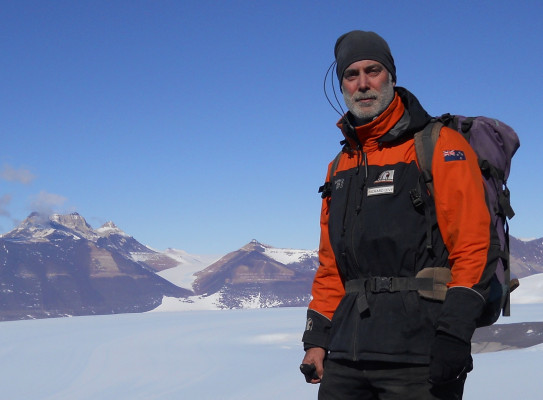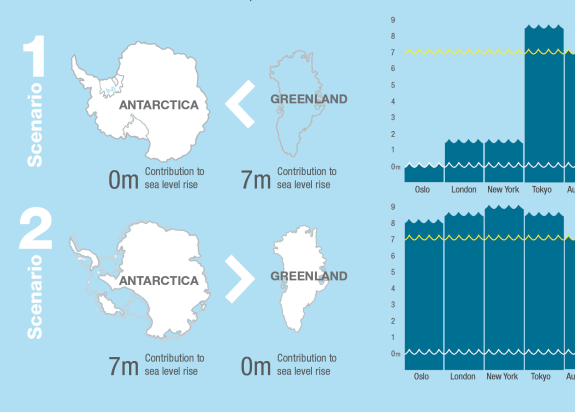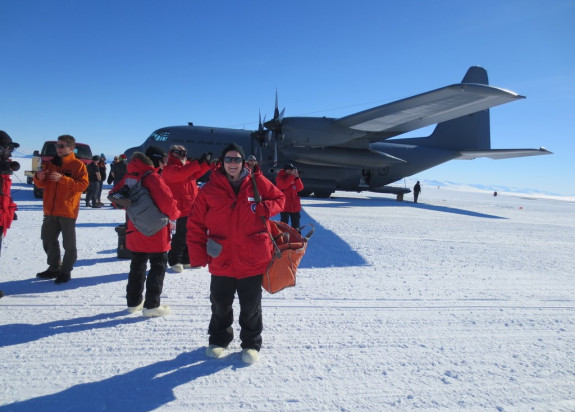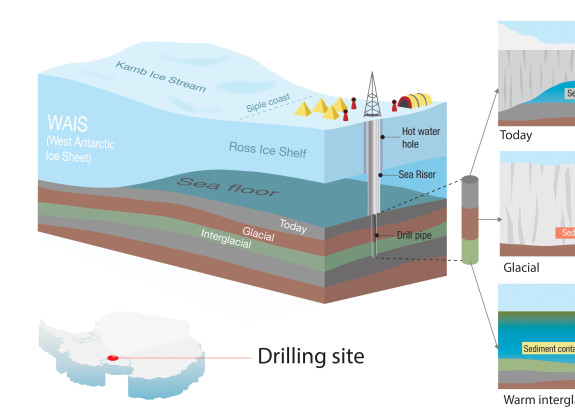
New drill to unlock secrets of Antarctic ice shelf

A ground-breaking Antarctic drilling system has been designed and constructed in Porirua.
The new drill is designed to uncover environmental secrets hidden beneath Antarctica’s vast Ross Ice Shelf, with the ultimate goal of helping us understand the impact of Antarctica’s melting ice sheets on communities around the world.
One of the projects leaders, GNS Science’s Dr Richard Levy, says the drill will allow us to recover sediment cores from deep beneath the seafloor, far below the surface of the Ross Ice Shelf near a place where the West Antarctic Ice Sheet begins to float.
“This is something that nobody has yet been able to achieve," Richard says. "Sediment cores are crucial for climate studies as they allow us to glimpse into past periods when climate was warmer than today and like that we expect in the coming decades. Every core we collect will contain layers of data that allow us to look back hundreds, thousands, and millions of years into Earth’s past. Through our frontier geoscience and cutting-edge technology, we can uncover a treasure trove of information. New data we glean from the cores will give us unique insight into past environmental change in Antarctica.


One of the main aims is to reveal the sensitivity of the Ross Ice Shelf and West Antarctic Ice Sheet to past warming to help us model the future impact of climate change on the ice sheet and determine how much sea level will rise as the ice melts.
The ambitious project is called ‘Sensitivity of the West Antarctic Ice Sheet to 2°C warming (SWAIS 2C)(external link), an international initiative involving researchers from around the world.
Dr Molly Patterson, another project leader, says that future change in Antarctica will have far-reaching impact on societies across our planet. “At the current rate of CO2 emissions, global mean temperatures will be 1.5°C and 2°C above pre-industrial levels in 10 to 20 years. This amount of warming could result in several metres of sea level rise over the coming centuries."

No walk in the park
All that stands between the scientists and this environmental data is a 700 metre-thick slab of floating ice.
Dr Levy says the Ross Ice Shelf currently acts as a buttress. “Slowing the flow of the West Antarctic Ice Sheet into the ocean and limiting sea level rise. If the ice shelf collapses the ice sheet will follow and the rate and amount of sea level rise will rapidly increase. We are obviously grateful the ice shelf is there and we certainly hope it remains, but it means we have to come up with innovative ways to access the hard-to-reach records.”
If the ice shelf collapses the ice sheet will follow and the rate and amount of sea level rise will rapidly increase. We are obviously grateful the ice shelf is there and we certainly hope it remains, but it means we have to come up with innovative ways to access the hard-to-reach records.
Delivering the drill
The somewhat daunting task to design and build the bespoke system falls on Engineering Manager Darcy Mandeno and Antarctic Drilling Adviser Alex Pyne from Victoria University of Wellington’s Antarctic Research Centre and staff at Webster Drilling and Exploration (WD&E) in Porirua City.
Mandeno says no one has ever drilled deep into the Antarctic seabed at a location so far from a major base, and so close to the centre of the West Antarctic Ice Sheet. “The thin layer of ocean beneath the ice shelf at the study site has been accessed a few times, but a deep sediment core has never been recovered."
The team will first use a hot water drilling system to melt a hole through the Ross Ice Shelf. This key piece of equipment has already been built and successfully used on the ice. They will then install the new sediment drilling system, known as the Antarctic Intermediate Depth Drill (AIDD) and retrieve the sediment crucial to the research by coring down into the rock layers below the sea floor. Once the cores are retrieved from beneath the seafloor and brought up to the ice shelf surface, the science team will work fast to X-ray the cores, complete some initial analyses, and ensure the cores are safely stored and kept in pristine condition.
Drilling into the science
Once the cores have been recovered, they will be flown back to New Zealand’s Antarctic hub at Scott Base and shipped to the Otago Repository for Core Analysis (ORCA) at Otago University in Dunedin, New Zealand. The cores will ultimately be stored at Oregon State in the United States where they will be available to the global research community for ongoing research.
Dr Levy says data from the cores will be used to reconstruct past ocean temperatures and sea-ice extent, and determine ice-shelf and ice sheet response to prehistoric climate variability and periods of past warmer-than-present conditions including during intervals of elevated atmospheric CO2 and temperature. These observations of past environmental conditions will be used by the teams numerical modellers who use computers to conduct experiments that help examine and understand interactions between the Earth’s crust, oceans, atmosphere, and ice and how these interactions evolve as the climate cools and warms.

Every metre of sediment we acquire is going to allow numerous studies and we are currently sorting through the various projects that our scientists are proposing and to ensure the right people get the right samples.
“Then it’s up to our modellers who use equations and algorithms to run experiments to explore processes that might explain the changes we observe in the cores. These ‘paleo-validated’ models then help us see the future, they allow us to project the global consequences of change in Antarctica.”
The field team will also deploy oceanographic instruments beneath the ice shelf through the access hole made by the hot water drill.
Dr Levy says the global community depends on Antarctic scientists to generate new insight into ice sheet response to this level of warming and to integrate this knowledge with colleagues working on other components of the Earth system.
“Getting this kind of project off the ground takes the blood, sweat and tears of a lot of people from around the world. Our proposed approach to this drilling is novel and risky, but it’s the only way we are going to get those critical samples. If we can pull this off and prove the concept, it will open up new opportunities to obtain key records of environmental change and ice sheet dynamics at other remote locations across Antarctica. This comprehensive sampling approach will allow us to build a much better picture of how Antarctic ice will respond to warming, which parts will melt first, and which parts will remain. This knowledge is critical as humanity grapples with the challenge of sea level rise. We know we must adapt to at least 30 cm of sea level rise over the coming decades, but we must also plan for a range of possible futures with the potential for significantly higher values. SWAIS 2C researchers and the drilling machines that Darcy, Alex, Adam and the team at Websters are building will help us ‘see’ those possible futures.”
SWAIS 2C project operations are supported through funds from New Zealand, the United States, Germany, the United Kingdom, Australia, Japan, and the Republic of Korea. Support is also provided by the International Continental Scientific Drilling Programme (ICDP). This project is the first in Antarctica for ICDP. New Zealand participation is supported through the Antarctic Science Platform’s Ice Dynamics Project.
Antarctic field operations are scheduled to begin in November 2023 and will continue through 2024 with scientific studies continuing through to 2027.
